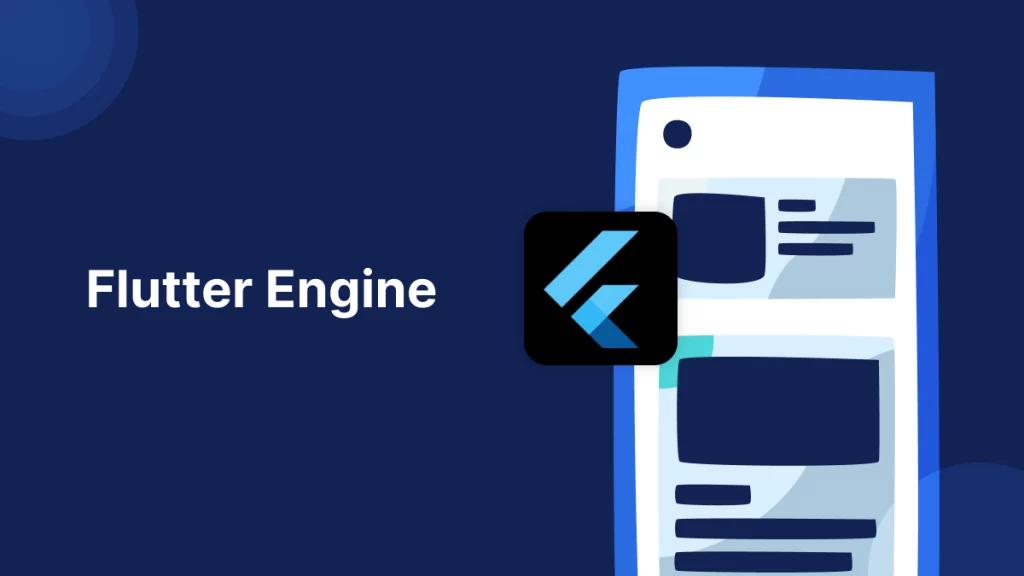Ever wonder how Flutter turns a single codebase into apps for both iOS and Android? The magic lies in the Flutter Engine — the core that powers Flutter’s cross-platform capabilities.
In this blog, we will dig deeper and uncover the secrets of Flutter’s cross-platform capabilities and learn about the Flutter Engine.

What is Flutter Engine?
The Flutter Engine, part of the SDK, manages rendering, input, and text layout. It uses Skia to bypass native UI, drawing directly on the screen for a seamless, consistent experience.
It is a low-level runtime, serving as the foundation beneath the Flutter framework manages core functionalities and interacts directly with the hardware and operating system.
The Flutter Engine, written in C++, is part of the Flutter SDK but works independently. While the framework offers high-level widgets and services, the engine bridges Flutter with the native platform.
How does Flutter Engine Work?
it is a bridge between Dart and native platforms ensuring flutter apps run seamlessly across multiple platforms. Let’s break down the process step by step and understand how it works:-
Step1:- Flutter Framework and Dart Code
- Flutter apps use Dart, a high-level language, to create high-performance, cross-platform applications for iOS, Android, web, and desktop.
- The framework consists of widgets, state management, animations, and UI-related code, all written in Dart.
Step 2:- Executing Data Code
Dart code can be compiled using 2 different methods that include:-
- Just-in-Time (JIT) Compilation for development (which enables features like hot reload).
- Ahead-of-time (AOT) Compilation for production builds (for optimized performance).
Step 3:- Flutter Engine Components
It has several key components that interact to make Dart code run natively on respective platforms.
- Dart Runtime (VM):- The Dart VM uses JIT and AOT to compile the Dart code dynamically at runtime, allowing for faster iterations with hot reload and optimized performance by avoiding the overhead of runtime compilation.
- Platform Channels: A method channel is a communication mechanism that allows Dart code to send messages to native code (in Swift/Objective-C for iOS and Java/Kotlin for Android) and vice versa.
- Rendering and UI:- Flutter apps don’t rely on the native platform’s UI components. Instead, everything is rendered through Skia. Skia is a 2D graphics library that draws the UI elements (widgets, text, images) onto the screen.
- Compilation to Native Code:- The Dart compiler translates code into native ARM machine code (for mobile devices) before running the app.
- Interaction with Native Platform:- After compilation, the compiled Dart code interacts with the native platform using the Flutter Engine. The Engine provides access to low-level APIs and hardware resources, handling tasks like:
- Graphics rendering (via Skia)
- Input handling (touch gestures, clicks)
- Text rendering (using libraries like Harfbuzz)
- Accessing platform APIs (camera, sensors, etc.)
- App Lifecycle:- The Flutter Engine manages the app’s lifecycle, including bootstrapping the Dart runtime, launching the app, and managing resources like memory and CPU.
Flutter Engine and WidgetBindings
Like the Flutter Engine, WidgetsBinding is a key concept in Flutter’s internals. It bridges communication between the Engine and the framework.
WidgetsBinding handles low-level tasks like rendering, input, and platform communication. It serves as the framework’s connection to the engine, orchestrating its operations.
Conclusion
In this blog, we explored the Flutter Engine’s role in enabling cross-platform capabilities. It bridges Dart code with native platforms, handling rendering and input for a seamless app experience.
Keep your Flutter learning journey alive by diving into more insightful content on Mobikul Blogs — your go-to source for everything Flutter!

Be the first to comment.